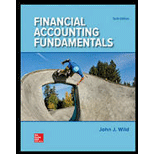
1.
Indicate the total amount of cash and cash equivalents of Incorporation A for the fiscal years ended September 26, 2015, and September 27, 2014, and compute the percentage of cash in current assets, total current liabilities, total shareholders’ equity, and total assets for the said dates, and interpret the trends.
1.
Explanation of Solution
Cash and cash equivalents: Cash is the money readily available in the form of currency. Cash equivalents are the near-cash items, which are readily convertible into cash. Cash equivalents have a maturity period of three months, or less than 3 months. Cash equivalents are reported along with cash in the assets section of the
Balance of cash and cash equivalents: Cash and cash equivalents of Incorporation A as on September 27, 2014 are $13,844,000,000 and on September 26, 2015 are $21,120,000,000.
Percentage of cash in current assets: In 2015, Incorporation A represents 23.6%
Percentage of cash in current liabilities: In 2015, Incorporation A represents 26.2%
Percentage of cash in shareholders’ equity: In 2015, Incorporation A represents 17.7%
Percentage of cash in total assets: In 2015, Incorporation A represents 7.3%
Interpretation of the trends: Since cash and cash equivalents increased much more than the respective bases, the percentage of cash increased. Hence, the liquidity position of Incorporation also increased.
Note: Refer to the Appendix A of the textbook, to find the referred values of Incorporation A, in the Consolidated Balance Sheets, as at September 26, 2015.
2.
Indicate the percentage change in beginning and ending cash and cash equivalents as per the statement of
2.
Explanation of Solution
Percentage of cash and cash equivalents for the year ended September 26, 2015: In 2015, cash and cash equivalents changed from $13,844,000,000 to $21,120,000,000. The percentage increased by 52.6%
Percentage of cash and cash equivalents for the year ended September 27, 2014: In 2014, cash and cash equivalents changed from $14,259,000,000 to $13,844,000,000. The percentage decreased by 2.9%
Note: Refer to the Appendix A of the textbook, to find the referred values of Incorporation A, in the Consolidated Balance Sheets, as at September 26, 2015.
3.
Compute days’ sales uncollected of Incorporation A, for the years ended September 26, 2015 and September 27, 2014.
3.
Explanation of Solution
Days’ sales uncollected: This ratio measures the number of days a company takes to collect its
Formula for days’ sales uncollected:
Compute days’ sales uncollected of Incorporation A for the year ended September 26, 2015.
Compute days’ sales uncollected of Incorporation A for the year ended September 27, 2014.
Analysis: The days’ sales uncollected has changed from 34.86 days in 2014 to 26.31 days in 2015. This denotes that the collection period decreased from 2014 to 2015, hence, the efficiency of collection of receivables increased.
Note: Refer to the Appendix A of the textbook, to find the referred values of Incorporation A, in the Consolidated Balance Sheets, as at September 26, 2015.
4.
Compute days’ sales uncollected of Incorporation A, for the year ended September 30, 2017 and September 24, 2016.
4.
Explanation of Solution
Compute days’ sales uncollected of Incorporation A for the year ended September 30, 2017.
Compute days’ sales uncollected of Incorporation A for the year ended September 24, 2016.
Analysis: The days’ sales uncollected has changed from 26.67 days in 2016 to 28.46 days in 2017. This denotes that the collection period increased from 2014 to 2015, hence, the efficiency of collection of receivables decreased.
Note: Refer to the website given in the question for the values of Incorporation A, in the Consolidated Balance Sheets, as at September 30, 2017.
Want to see more full solutions like this?
Chapter 6 Solutions
FINANCIAL ACCT.FUND(LL)W/ACCESS>CUSTOM<
- I need the correct answer to this general accounting problem using the standard accounting approach.arrow_forwardI need help solving this general accounting question with the proper methodology.arrow_forwardI need the correct answer to this general accounting problem using the standard accounting approach.arrow_forward
- Can you solve this general accounting question with the appropriate accounting analysis techniques?arrow_forwardPlease explain the solution to this general accounting problem with accurate principles.arrow_forwardPlease explain the solution to this general accounting problem with accurate principles.arrow_forward

 AccountingAccountingISBN:9781337272094Author:WARREN, Carl S., Reeve, James M., Duchac, Jonathan E.Publisher:Cengage Learning,
AccountingAccountingISBN:9781337272094Author:WARREN, Carl S., Reeve, James M., Duchac, Jonathan E.Publisher:Cengage Learning, Accounting Information SystemsAccountingISBN:9781337619202Author:Hall, James A.Publisher:Cengage Learning,
Accounting Information SystemsAccountingISBN:9781337619202Author:Hall, James A.Publisher:Cengage Learning, Horngren's Cost Accounting: A Managerial Emphasis...AccountingISBN:9780134475585Author:Srikant M. Datar, Madhav V. RajanPublisher:PEARSON
Horngren's Cost Accounting: A Managerial Emphasis...AccountingISBN:9780134475585Author:Srikant M. Datar, Madhav V. RajanPublisher:PEARSON Intermediate AccountingAccountingISBN:9781259722660Author:J. David Spiceland, Mark W. Nelson, Wayne M ThomasPublisher:McGraw-Hill Education
Intermediate AccountingAccountingISBN:9781259722660Author:J. David Spiceland, Mark W. Nelson, Wayne M ThomasPublisher:McGraw-Hill Education Financial and Managerial AccountingAccountingISBN:9781259726705Author:John J Wild, Ken W. Shaw, Barbara Chiappetta Fundamental Accounting PrinciplesPublisher:McGraw-Hill Education
Financial and Managerial AccountingAccountingISBN:9781259726705Author:John J Wild, Ken W. Shaw, Barbara Chiappetta Fundamental Accounting PrinciplesPublisher:McGraw-Hill Education





